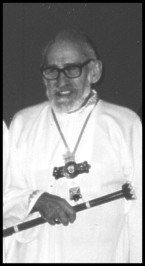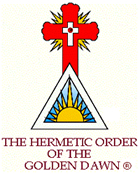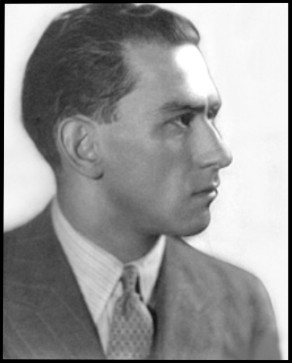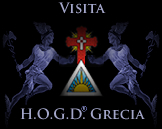"...it
is essential that the whole (Golden Dawn) system
should be publicly
exhibited so that it may not be lost to mankind.
For it is the heritage of
every man and woman—their spiritual birthright."
Israel Regardie, My Rosicrucian Adventure
"Since 1920 Dr. Regardie has done much to remove the excessive secrecy
surrounding modern occultism."
David Conway, The Complete Magic Primer
"A number of people have asked how Regardie stacked up against the
higher Grades of the Stella Matutina. Having met a number of people who
claimed 8=3 and one of 9=2 rank …, I would safely say he was far ahead
of them in technical expertise that they could not be considered in the
same league as he."
Pat Zalewski, The Secret Inner Order Rituals of the Golden Dawn
"That the rebirth of occult magic has taken place in the way it has
can be very largely attributed to the writings of one man, Dr. Francis
Israel Regardie."
Francis King and Isabel Sutherland, The Rebirth of Magic
Before his death on
March 10, 1985, Israel Regardie was considered by many people to be the
last living Adept of an illustrious magical current known as the
Hermetic Order of the Golden Dawn. The tradition represented by the
Golden Dawn and its two later incarnations, the Stella Matutina and the
Alpha et Omega, which were created after the original Order split into
various factions, attracted many influential occultists of the late
19th century and early 20th century. Among these were Dr. William W.
Westcott, Samuel L.
Mathers,
Arthur Edward Waite, William Butler Yeats, Aleister Crowley, and Dion
Fortune. Yet even among this extraordinary ensemble of knowledgeable
magicians, Regardie ranks high as an authority of prominence.
Early History
The son of poor Jewish immigrants, Israel Regudy,
was born in London on November 17, 1907. During WWI, an older brother
joined the army and his surname was accidentally marked down as
"Regardie." This was adopted as the family name. His family moved to
Washington DC in 1921 when he was 13 years old. Early on, he cultivated
an interest in the theosophical works of Madame Blavatsky, yoga, and
Hindu philosophy. Regardie often visited the Library of Congress, which
he called "his second home." Not long after, Regardie found a Hebrew
tutor and learned to read Hebrew effortlessly, a ability that would aid
him enormously in his Qabalistic studies.
He applied for membership to the Washington College of the SRIA
(Societas
Rosicruciana in America) on February 18, 1926. He was initiated
into the
Neophyte grade on March 18, 1926, and advanced to the Zelator grade on
June 2,
1927. (More info
on Israel Regardie and the SRIA available here.)
Around 1925 or 1926, Regardie discovered a book which aroused his curiosity. The book was Part One of Book Four by Aleister Crowley. Regardie wrote to Crowley in Paris and eventually
received a reply to his inquiry. Soon after, Crowley offered him
a job as his secretary in Paris. The young Regardie saw this as a
opportunity to learn magic from a published authority, and so in
October of 1928, Regardie went to France to accept the job. For the
next three years, Regardie tried to get his employer to teach him the
magical
arts. However, Crowley did not offer to teach Regardie either magic or
yoga, and Regardie, a reserved and modest young man, did not pursue the
matter. Instead he continued to study magic on his own, reading every
magical book, article or manuscript that was available to him.
Crowley's reputation, fueled by the British
tabloids, eventually got him in trouble with the French authorities and
he had to leave the country. A few months later, Regardie joined him in
England. However, Crowley's publisher went bankrupt and as a result, he
could no longer afford to keep Regardie on as his secretary. In 1930,
Regardie tried to repair Crowley's sullied image by co-authoring a book
called The Legend of Aleister Crowley (1930). Regardie and Crowley
drifted apart and later had a complete falling out.
Regardie was deeply wounded by the breakup of the friendship and was
only able to pardon Crowley in his later years. Many years earlier he
tried to repair Crowley’s tarnished public image by co-authoring a book
called The Legend of Aleister Crowley (1930). Regardie’s later books
offered a more balanced and matured view of Crowley than did his
earlier works. Regardie’s charitable nature and his ability to be
forgiving toward his old friend was evident in such works as The Eye in the Triangle. But he was also irritated when people
linked him solely to Crowley’s teachings.
“One of his pet hates,” writes Pat Zalewski, “was people associating
him with Crowley’s brand of Thelemic Magic, and the Book of the
Law....I can still recall him thumping the table at dinner one night
saying ‘Dammit, I’m a Golden Dawn man and not a Thelemite, and I wish
people would realize it.’ He did, however, hold a lot of respect for
McMurtry and some of the abilities of the O.T.O.” (1) In any event, Regardie had many friends and associates in the Thelemic community.
Magical History
Regardie published his two books, A Garden of Pomegranates and The Tree of Life in 1932. The first book contained Regardie's Qabalistic studies based upon his own research from various sources. The Tree of Life is considered one of the most complete and understandable texts on
practical magic ever written. This text was essentially a restatement
of Golden Dawn
teachings. When The Tree of Life was published, it
caused a lot of excitement among esoteric circles. Although the Golden
Dawn had ceased to exist in 1903, it continued to live on in its
descendant orders, the Stella Matutina and the Alpha et Omega. With the
encouragement and assistance of Dion Fortune, Regardie joined the
Stella Matutina.
Many members of both the Stella Matutina and the
Alpha et
Omega remembered Crowley as a disruptive insurgent from years before,
therefore Regardie’s previous connection to Crowley caused some members
to lash out at him. One of the leaders of the Alpha et Omega, E. J.
Langford-Garstin, went so far as to write Regardie in a letter
condemning him in no uncertain terms and asking him to never again
mention the name of the Golden Dawn in print. Other members, most
notably Dion Fortune, defended him as can be seen from her article in
the Occult Review, praising Regardie’s The Tree of Life.
Her article did more to reveal the true essence of the Golden Dawn, and
to a broader audience, than anyone had divulged previously. The chiefs
of the Stella Matutina seemed to play both ends against the middle. A
representative of the Order wrote a letter to Dion Fortune strongly
agreeing with her viewpoint, and another letter to Langford-Garstin
which stated how irresponsible he considered Dion Fortune’s actions and
sentiments to be. In one of the great faux pas in the history of esoteric groups, the two letters ended up in the wrong envelopes.
As a result, the door of initiation swung open for
Regardie. With Dion Fortune’s support, he was invited to join the
Stella Matutina. In his words: “It was on the basis of
The Tree of Life, that I was invited to join the
Order.” In 1933, Regardie joined the Order and made rapid progress
through the grades due to his extraordinary abilities. However, in 1933
the order was in an advanced state of decline. Regardie was extremely
vexed with the chiefs of the Stella Matutina for being far too
concerned with attaining grandiose titles and not concerned enough with
the practice of magic. He concluded that the Order and its teachings
would not survive much longer without some effort to place those
teachings in the hands of a greater number of people who could
appreciate them. After attaining to the grade of Theoricus Adeptus
Minor, Regardie left the Order in December of 1934. In 1937 he
published the bulk of the Golden Dawn's rituals and teachings in four
volumes called simply The Golden Dawn. Regardie made his reasons for publishing these teachings well known to interested readers:
"...it is essential that the whole system should be
publicly exhibited so that it may not be lost to mankind. For it is the
heritage of every man and
woman—their spiritual birthright." ..."My motives have been to prove
without a doubt that no longer is the Order the ideal medium for the
transmission of Magic, and that since there have already been several
partial and irresponsible disclosures of the Order teaching, a more
adequate presentation of that system is urgently called for. Only thus
may the widespread misconceptions as to Magic be removed."— My Rosicrucian Adventure (1936)
Throughout history, many courageous individuals have
had to make difficult choices which effect great numbers of people.
Regardie's choice was this: keep his oath of secrecy to those who were
letting the Order lapse into a severe state of neglect, or publish them
and suffer criticism but be assured that the system itself would
survive. Because of Regardie's difficult and unselfish decision to
break his oath of secrecy to a lethargic and dying Order, the valuable
teachings of the Golden Dawn became available to all true seekers,
regardless of their education, background, location, circumstances, or
personal finances.
Some people openly criticized Regardie for his
actions, although many Adepts of the Order were secretly grateful to
him at the time. A small number predicted that some dire consequence
would befall Regardie for his action. It didn't. And just as Regardie
had foreseen, a few years later most temples of the Stella Matutina and
the Alpha et Omega slowly atrophied and disappeared. In the name of
secrecy and elistism, many misguided temple chiefs had the appalling
habit of destroying Order documents, rather than passing them on to a
new generation of seekers. Regardie's decision was obviously the right
one. But because of Regardie's actions, all students of magic today owe
him a enormous debt of gratitude. Today, a growing number of authors
are writing books designed to make the teachings of the Golden Dawn
more accessible. Today, more people than ever now refer to themselves
as "practicing Golden Dawn magicians." Some work in groups, others in
private. But all of them should be thankful for the foresight of Israel
Regardie. As
one authority states:
"...most of the curriculum of the Golden Dawn
through the Subgrade of Zelator Adeptus Minor has been publicly
available for half a century, and none of the problems of the modern
world are even remotely connected with the release of that knowledge,
and while there is certainly power in those teachings, it is not a
dangerous power; the Mysteries entrusted to the Order are connected
with spiritual growth and evolution, and the last thing from which
Western civilization needs to be protected is spiritual growth and
evolution." (2)
Regardie also practiced what
he
preached. Having recently acquired the former archives of the Israel
Regardie Foundation, and having seen the vast amount of personal work
and research that Regardie did in the areas of
Qabalah, Psychology, and Enochian Magic, we can certainly testify to
fact that he was no mere armchair occultist—he was a first-rate
Theurgist and an expert in the field of magic.
In 1936-37, Regardie wrote The Philosopher's Stone,
a book about alchemy from a Jungian perspective. At the time he did not
believe in the validity of laboratory alchemy. (Working with practical
alchemists such as Frater Albertus of the Paracelsus Research Society
in the 1970's caused him to change his mind on the matter in his later
years. Unfortunately, one of Regardie's alchemical experiments went
wrong and he seriously burned his lungs in the lab. He gave up the
practice of alchemy and suffered from the effects of the accident until
the end of his life.) Regardie returned to the U.S. in 1937, where he
studied psychology and psychotherapy. Previously in London, he had
studied psychoanalysis with Dr. E. Clegg and Dr. J. L. Bendit. Later,
he studied psychotherapy under Dr. Nandor Fodor. He entered the
Chiropractic College of New York City to study psychology. His training
encompassed the techniques of Freud, Jung, and Reich. After graduating
in 1941, he took up practice as a lay analyst.
In 1938, he published The Middle Pillar,
which gave step-by-step details on how to perform practical exercises
of Golden Dawn ceremonial magic. In the same book, Regardie compared
these magical techniques to the methods and hypotheses of
psychoanalysis. He sought to remove the synthetic walls that had been
erected between magic and psychotherapy. For a time Regardie explored
Christian mysticism, and wrote about his ideas in The Romance of Metaphysics.
In 1947, Regardie relocated to California and set up
practice as a chiropractor and a Reichian therapist. He taught
psychiatry at the Los Angeles College of Chiropractic and contributed
articles to various psychology magazines. He also wrote several more
books including: The Art and Meaning of
Magic,
Roll Away the Stone, Twelve Steps to Spiritual Enlightenment, A
Practical Guide to Geomantic Divination, How to Make and Use Talismans, and Foundations of Practical Magic. Regardie retired from his practice in 1981 and moved to Sedona, Arizona where he continued to write. His later books included Ceremonial Magic, The Lazy Man's Guide to Relaxation, and The Complete Golden Dawn System of Magic.
One of Regardie's primary objectives was to preserve the
teachings of the Golden Dawn. But in addition to this, he had another task:
"The
second significant task carried out by Regardie was, as an Adept, to bring a
valid branch of the initiatory lineage of the Golden Dawn to America the
alchemical melting pot where the New Age was incubating. Such tasks are not
always easy. A. M. A. G. waited here four decades until the threads of the
pattern came together. Then, in one of those graceful synchronicities which
often play midwife to significant magical events, a couple in Georgia were
inspired—at that time scarcely aware of what they were undertaking—to build
a Rosicrucian Vault, the powerful ritual chamber required to pass on the Adept
Initiation, at precisely the time when two magicians (one on the east coast of
the United States and one on the west coast), unknown to each other or to the
Georgia couple, came to be ready to receive that Initiation. And A. M. A. G.,
with the right to confer the Initiation in such a Vault, was the connecting link
among them. And so, in one remarkable weekend, Regardie presided over two
Initiations into the Inner Order, the first and the last which he ever
performed; and the Lamp of the Keryx was passed into American hands." (3)

Regardie's Order motto was Ad Majorem Adonai Gloriam
"To the Greater Glory of God"
Regardie continued to give advice on health and
magical matters until the end of his life.
He died of a heart attack on March 10, 1985 while having dinner with
friends at
one of his favorite restaurants. Although now he is gone, his written
works, which many will agree are refreshing, inspiring, and
down-to-earth, continue to teach and inspire new generations of
students.
Endnotes
(1) Pat Zalewski, The Secret Inner Order Rituals of the Golden
Dawn, 179–180.
(2) Adam P. Forrest, in
the Epilogue of Secrets
of a Golden Dawn Temple, (pages 540–541) reprinted as the Foreword to Ritual
Use of Magical Tools (page xx).
(3) Ibid. Secrets of a Golden
Dawn Temple, (page 541) Ritual Use of Magical Tools (page xx–xxi).
Photos are courtesy of the Israel Regardie Archives, H.O.G.D.
private collection.
Copyright ©1997 by Chic Cicero & Sandra Tabatha Cicero
Many thanks to www.hermeticgoldendawn.org for permission to replicate this article
|











